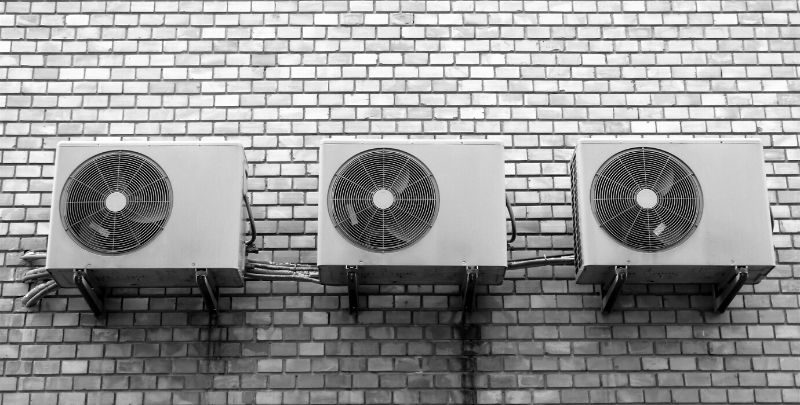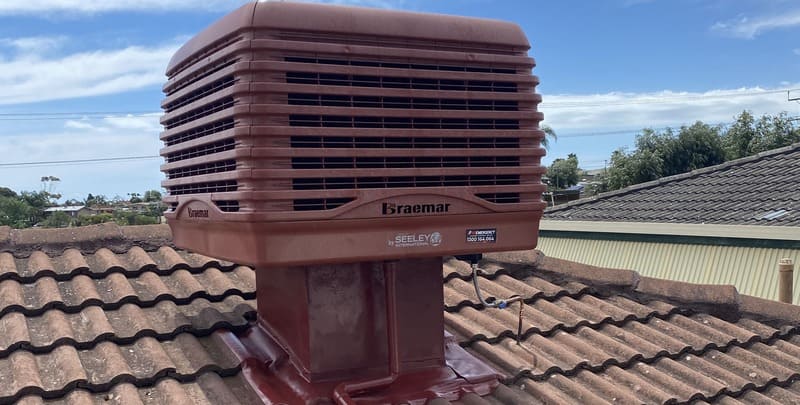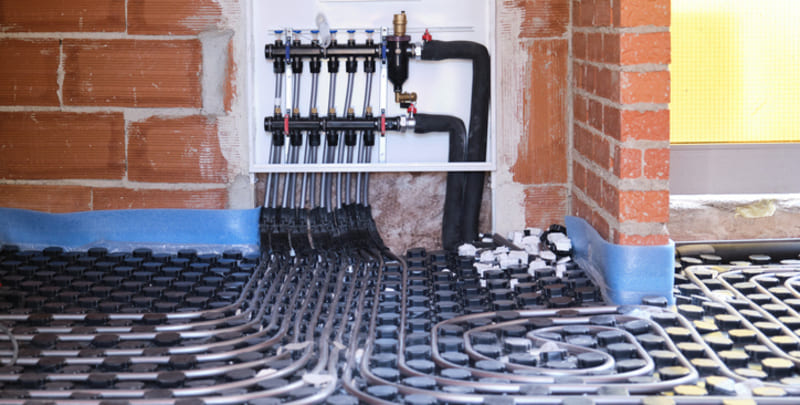
A Quick Guide to the Different Types of Heating and Cooling Systems
Where would we be without coolers in the summer and heaters in the winter? Our lives would be an uncomfortable mess for sure.
Now you’ve probably heard a lot of different terminologies thrown around when talking about the types of heating and cooling systems that are on the market.
Let’s break it down so you have a super clear understanding of what’s going on, and how exactly these systems differ from each other. You might just learn something totally new about the air conditioner you have, or you might decide that another type of heating and cooling system is better suited to your house, who knows?
Split Systems
Split system units are one of, if not the most popular form of heating and cooling installed into houses. A split system unit comprises a wall-mounted internal unit that looks like a long rectangular box on your wall.
This is connected to an external compressor unit that draws in air from outside and converts it to the temperature you set your system to. It does this by using refrigerant technology. Reverse cycle split systems can heat as well. They are often available as either a single unit, for one room, or multi-unit for multiple rooms, and will always only have the one compressor.
Having multiple split systems (known as a multi-head split system) throughout your house allows for flexibility and climate control in each room, rather than the whole house being one temperature because everyone has different preferences.
These systems are generally a top choice for living rooms, kitchens and general everyday living spaces. They always look sleek and stylish, fitting in with home décor. They provide ease of control with remote operation, so you can wake up on a cold winter morning and you won’t even have to leave the protection of your warm and cosy quilt to put the heater on.
Most of the time a split system is a reverse cycle air conditioner, providing both heating and cooling, which is convenient and gives you climate control all year round. Let’s take a more detailed look.
Reverse Cycle Air Conditioners
Reverse cycle air conditioners, also known as heat pumps, are a game-changer in the world of home climate control. These nifty devices do double duty, providing both cooling and heating functions in one unit.
Here’s why reverse cycle air conditioning can be a top choice for year-round comfort:
- Efficient heating and cooling: Reverse cycle air conditioners work by reversing the refrigeration cycle. In hot weather, they extract heat from inside your home and release it outside, cooling your space. When it gets chilly, they absorb heat from the outdoor air and bring it inside to warm your rooms. This process is highly efficient and cost-effective, as it uses the same system for both purposes.
- All-season solution: Say goodbye to the hassle of switching between your air conditioner and heater. A reverse cycle system provides electric heating and cooling. You can maintain a comfortable temperature throughout the year, no matter the weather outside.
- Energy savings: These systems are known for their energy efficiency. They consume less electricity compared to traditional heating methods like electric furnaces or baseboard heaters, helping you save on energy bills.
- Zone control: Many reverse cycle air conditioners come with zone control options, allowing you to heat or cool specific areas of your home independently. This means you can avoid wasting energy on unoccupied rooms.
- Environmentally friendly: Since they transfer heat instead of generating it, reverse cycle air conditioners are eco-friendly and produce fewer greenhouse gas emissions.
Whether you’re battling the summer heat or facing winter’s chill, a reverse cycle air conditioner is a versatile and cost-effective choice for maintaining a comfortable indoor environment year-round. Enjoy the convenience and efficiency of a single system that does it all.
Ducted Systems
A ducted heating or cooling system is a fantastic way to have your whole house set to one temperature if that’s what you prefer. A ducted system comprises of one central unit that feeds air through vents in the ceiling, dispersing it into each room.
Most ducted systems do allow you to turn off certain vents for added flexibility. Ducted systems have their pros and cons. They can be expensive to install and maintain due to their sheer size and the engineering required. They also use a lot of energy to operate.
Some systems also disperse rather dry air and can carry dust and other particles that build up within the vents. This can be harmful to both your lungs and skin but can avoided with regular servicing and cleaning.
On the plus side, ducted systems are a great way to provide your house with heating and cooling without any unsightly units anywhere in your house. The vents are recessed into the ceiling, so you hardly even know they’re there.
As previously mentioned, ducted units give you full house control, and often reach your desired temperature very quickly. The energy efficiency of ducted heating and cooling systems is also impressive, particularly considering that zoning controls allow you to only heat or cool the room(s) that you want.

Evaporative Cooling
You may be walking down the street and see a large cube sticking out the top of someone’s house. You’ve probably wondered what exactly that is. Well, that’s an evaporative cooler, in case you didn’t already know.
Now, the basic theory behind evaporative cooling is that it works on constantly replacing the air in a room. This means it is very important that the areas you want to cool are open and have adequate airflow. The average evaporative cooler needs between 2m²-3m² of open area.
Evaporative coolers, in simple terms, work by running air over wet pads that use the moisture to cool the air as it passes through. There’s some pretty gnarly science behind it that can get a little complicated, but basically, when water transitions from a liquid state to vapour, it absorbs heat and replaces it with cool air.
Evaporative coolers are most commonly found in the form of a ducted system throughout the house but are also available as free-standing portable coolers. Evaporative coolers are generally less expensive to install and operate compared to refrigerated air conditioning. They are also energy efficient and eco-friendly. Evaporative coolers increase humidity and work best in dry climates.
Gas Heating
If you’re in search of reliable and efficient heating, gas heating systems are highly recommended and have been a trusted choice for many years. A gas heater uses natural gas or LPG (liquefied petroleum gas) to generate heat, and here’s why they are a popular option:
- Efficient and cost-effective: Gas heating systems are known for their efficiency, converting a high percentage of the energy from the gas into heat. This translates to lower energy bills compared to electric heating, especially in regions where natural gas is abundant and affordable.
- Quick warm-up: Gas heaters provide rapid heating, making them ideal for colder climates. You won’t have to wait long to enjoy a toasty home.
- Consistent warmth: Unlike some electric heaters that may produce uneven heat, gas heating systems deliver consistent and even warmth throughout your space.
- Reliable performance: Gas heaters are dependable, even during power outages. Since they don’t rely on electricity to operate, you can stay warm when the electricity goes out.
- Reduced environmental impact: Modern gas heating systems are designed to be eco-friendly, producing lower emissions and reducing their carbon footprint. They are a more sustainable heating option compared to older, less efficient models.
It’s important to note that gas heating systems require proper ventilation and maintenance to ensure safety and efficiency. Regular inspections and servicing by a professional are essential.
Whether you opt for a gas furnace, boiler, a gas space heater or or a gas-powered fireplace, you can count on gas heating to keep your home warm and cosy during the coldest months, all while being cost-effective and reliable.
Beware of unflued gas heaters, which should only be used in larger spaces with adequate ventilation.
Hydronic Heating
When it comes to efficient and comfortable heating, hydronic heating systems are a top contender. Unlike traditional forced-air systems that blow hot air through ducts, hydronic heating relies on the circulation of warm water through pipes to heat your home.
Here’s why hydronic heating is gaining popularity:
- Radiant heat: Hydronic systems use radiant heating, which mimics the sun’s warmth. Pipes or panels installed beneath your floors, within walls, or even in your ceiling emit a gentle, consistent heat that warms objects and people in the room. Say goodbye to uneven temperatures and drafts caused by forced-air systems.
- Energy efficiency: Hydronic heating is highly efficient because water is an excellent conductor of heat. It retains warmth longer, allowing your system to run less frequently and consume less energy, ultimately reducing your heating bills.
- Zoned comfort: With a hydronic system, you can divide your home into zones, each with its own thermostat. This means you can customise the temperature in different areas, providing individualised comfort and saving energy by not heating unoccupied spaces.
- Quiet operation: Unlike noisy forced-air systems, hydronic heating operates silently. No more humming or blowing sounds disrupting your peace and quiet.
- Allergy-friendly: Hydronic systems don’t circulate dust or allergens like forced-air systems can, making them an excellent choice for those with allergies or respiratory issues. Essentially, your indoor air pollution is greatly reduced.
While the installation cost of hydronic heating (below) can be higher than traditional systems, the long-term benefits in comfort , energy savings and lower running costs often outweigh the initial investment. Experience the cosy warmth and energy efficiency of hydronic heating for your home.

Portable Air Conditioners
Portable air conditioners are a lifesaver when you need quick relief from scorching summer heat or stuffy indoor spaces.
These compact cooling systems are easy to move around, making them a versatile choice for homes, offices, and even small apartments.
Here’s why you should consider a portable air conditioner:
- Easy installation: Unlike traditional window or ducted AC units, portable air conditioners require no complicated installation. Just plug them into a standard electrical outlet, and you’re good to go. Plus, they come with an exhaust hose that you can easily attach to a window, so hot air is vented outside.
- Flexibility: Want to cool your bedroom at night and your living room during the day? Portable AC units can be wheeled from room to room, providing on-demand cooling wherever you need it.
- Cost-efficient: If you’re on a budget, portable air conditioners are often more affordable than central air systems. They’re a great option for cooling specific areas instead of the entire house.
- Energy-efficient: Many portable AC units come with energy-saving features, such as programmable timers and thermostat controls, helping you keep your electricity bills in check.
- No permanent installation: If you’re renting or don’t want to make permanent changes to your home, portable air conditioners offer a temporary cooling solution without any structural modifications.
- Versatile: Many portable units are reverse cycle air conditioners, so they can become a compact heating system in winter.
Remember, portable air conditioners are most effective in smaller spaces, so choose the right BTU (British Thermal Units) rating to match your room size for optimal cooling comfort. Stay cool and comfortable no matter where you are with a portable air conditioner.
To Sum Up …
There are many types of heating and cooling options out there that are not mentioned in this article. It’s important that you find the right solution for you so that you don’t have to be uncomfortable during the weather extremes.
If you ever need any assistance in determining what may be best for you, don’t forget Metropolitan Heating and Cooling is always here to help. Our technicians are fully trained and can assess your house to see what would fit best. We’re experts in all types of heating and cooling units.
Stay cool in the summer and warm in the winter with Metropolitan Heating and Cooling. From reverse cycle air conditioners to ducted gas heating systems, don’t hesitate to contact the climate control experts.
Please note: This information is provided for advice purposes only. Regulations differ from state to state, so please consult your local authorities or an industry professional before proceeding with any work. See our Terms & Conditions here.
Published: 21 February 2020